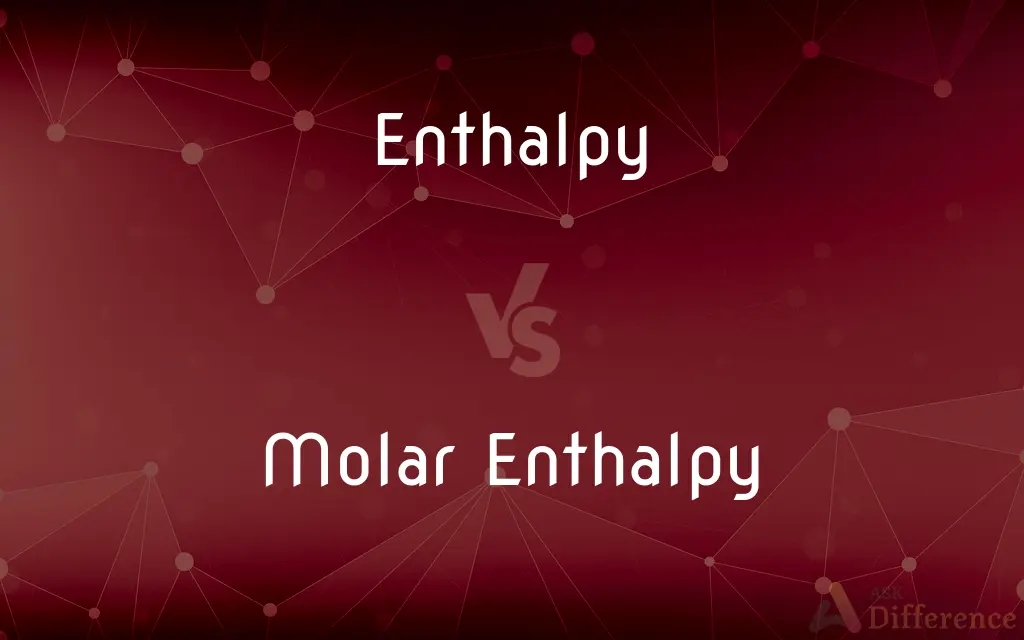Enthalpy vs. Molar Enthalpy — What's the Difference?
By Tayyaba Rehman & Fiza Rafique — Published on October 21, 2023
Enthalpy is the total heat content of a system, while molar enthalpy refers to the enthalpy change per mole of substance involved in a reaction.

Difference Between Enthalpy and Molar Enthalpy
Table of Contents
ADVERTISEMENT
Key Differences
Enthalpy, often denoted by H, is a thermodynamic property representing the total heat content of a system. It's a state function, which means its value depends only on the current state of the system, not on the path taken to reach that state. Molar enthalpy, on the other hand, is a specific type of enthalpy measurement. It relates to the enthalpy change associated with a chemical reaction for one mole of a substance.
Molar enthalpy provides a convenient way to express energy changes in chemical reactions. When chemists discuss reactions, they often refer to quantities in terms of moles. By understanding molar enthalpy, one can easily deduce the energy changes that occur in reactions involving different mole quantities. Enthalpy, without the "molar" qualifier, could refer to the heat content of any system, irrespective of its relation to chemical reactions or mole quantities.
In practical applications, enthalpy is crucial for engineers and scientists across various fields, especially in thermodynamics and physical chemistry. Whether analyzing the heat requirements for industrial processes or the energy changes in natural systems, enthalpy plays a foundational role. Molar enthalpy, more narrowly, aids chemists in predicting reaction outcomes and in designing reactions with desired energy profiles.
One can think of enthalpy as a broader concept, encompassing the total energy (in the form of heat) of a system. In contrast, molar enthalpy zooms in on the specific energy change that occurs for each mole of substance in a chemical process, giving detailed insights into individual reaction steps.
Comparison Chart
Definition
Total heat content of a system.
Enthalpy change per mole of substance in a reaction.
ADVERTISEMENT
Application
General thermodynamics, physical chemistry.
Specific to chemical reactions.
Units (common)
Joules (J) or calories.
Joules per mole (J/mol) or calories per mole.
Dependency
Depends on the state of the system.
Depends on the specific reaction and substance.
Context
Refers to heat content irrespective of moles.
Always related to a per mole basis.
Compare with Definitions
Enthalpy
Enthalpy is a measure of the total heat content in a system.
During a reaction, the system's enthalpy may increase or decrease.
Molar Enthalpy
Provides insights into individual reaction steps.
Each reaction step might have its own molar enthalpy value.
Enthalpy
Represents the internal energy plus the product of pressure and volume.
Enthalpy accounts for the work done during a process.
Molar Enthalpy
Specific to understanding energy changes in chemical reactions.
By knowing the molar enthalpy, chemists can predict reaction energy requirements.
Enthalpy
It's a state function, depending only on the system's current state.
Enthalpy changes are path-independent, focusing only on initial and final states.
Molar Enthalpy
Expressed in units of energy per mole, like Joules per mole.
The molar enthalpy of combustion for methane is about -890 kJ/mol.
Enthalpy
Denoted commonly by the symbol "H".
The ΔH value indicates the change in enthalpy during a reaction.
Molar Enthalpy
Essential for reaction stoichiometry and thermodynamic predictions.
Given the molar enthalpy, one can calculate total energy changes for various mole quantities.
Enthalpy
Often used to analyze heat changes in reactions and processes.
By measuring enthalpy changes, we can determine reaction feasibility.
Molar Enthalpy
Molar enthalpy refers to the heat change for one mole of substance.
The molar enthalpy of vaporization is the energy needed to vaporize one mole of a liquid.
Enthalpy
Symbol H A thermodynamic function of a system, equivalent to the sum of the internal energy of the system plus the product of its volume multiplied by the pressure exerted on it by its surroundings.
Enthalpy
A measure of the heat content of a chemical or physical system.
, where H is enthalpy, U is internal energy, p is pressure, and V is volume.
Enthalpy
(thermodynamics) a thermodynamic quantity equal to the internal energy of a system plus the product of its volume and pressure;
Enthalpy is the amount of energy in a system capable of doing mechanical work
Common Curiosities
How is molar enthalpy typically expressed?
Molar enthalpy is usually given in units like Joules per mole (J/mol).
Can enthalpy be negative?
Yes, a negative enthalpy indicates that heat is released by the system.
What influences a substance's enthalpy?
Factors like temperature, pressure, and phase can influence a substance's enthalpy.
How does molar enthalpy differ from enthalpy?
Molar enthalpy refers to the enthalpy change for one mole of substance in a reaction, while enthalpy is the overall heat content.
Why is molar enthalpy important in chemistry?
Molar enthalpy helps chemists understand energy changes per mole in reactions, aiding in predictions and design.
Can molar enthalpy values be used to determine reaction spontaneity?
While molar enthalpy provides energy information, spontaneity also requires considering entropy and temperature (Gibbs free energy).
Can enthalpy be directly measured?
Enthalpy itself isn't directly measurable, but changes in enthalpy (ΔH) can be determined experimentally.
What is enthalpy?
Enthalpy is a thermodynamic property representing the total heat content of a system.
What symbol denotes change in enthalpy?
The change in enthalpy is denoted by ΔH.
How is molar enthalpy measured?
Molar enthalpy can be measured using calorimetry, observing heat changes during reactions.
What role does molar enthalpy play in Hess's law?
Molar enthalpy values can be used in Hess's law to determine ΔH for reactions via summation of stepwise reactions.
Is enthalpy a state function?
Yes, enthalpy is a state function, meaning its value depends on the current state, not the path taken.
How is molar enthalpy useful in reaction stoichiometry?
Molar enthalpy allows for the calculation of energy changes based on mole quantities in balanced reactions.
Do all reactions have a molar enthalpy value?
Any reaction involving a change in enthalpy will have a molar enthalpy value when expressed per mole of substance.
Why is molar enthalpy crucial for thermodynamic tables?
Thermodynamic tables often list molar enthalpies for substances, allowing for quick reference and calculations in chemical studies.
Share Your Discovery

Previous Comparison
Publication vs. Journal
Next Comparison
Law of Attraction vs. Law of AssumptionAuthor Spotlight
Written by
Tayyaba RehmanTayyaba Rehman is a distinguished writer, currently serving as a primary contributor to askdifference.com. As a researcher in semantics and etymology, Tayyaba's passion for the complexity of languages and their distinctions has found a perfect home on the platform. Tayyaba delves into the intricacies of language, distinguishing between commonly confused words and phrases, thereby providing clarity for readers worldwide.
Co-written by
Fiza RafiqueFiza Rafique is a skilled content writer at AskDifference.com, where she meticulously refines and enhances written pieces. Drawing from her vast editorial expertise, Fiza ensures clarity, accuracy, and precision in every article. Passionate about language, she continually seeks to elevate the quality of content for readers worldwide.














































